Annotated Bibliography: Organisational Behaviours & Communication
VerifiedAdded on 2023/04/21
|5
|1370
|259
Annotated Bibliography
AI Summary
This annotated bibliography explores the critical role of communication in shaping organisational behaviours. It analyses five peer-reviewed journal articles, highlighting the importance of intercultural communication, internal communication, non-verbal behaviour, authentic leadership, and cross-cultural communication in the workplace. The analysis emphasizes how effective communication fosters employee engagement, productivity, and overall organisational success. It also addresses potential barriers to communication, such as cultural differences and the need for cross-cultural training to ensure efficiency and profitability in a diverse business environment. The bibliography concludes that adherence to organisational communication policies is essential for achieving long-term performance and effectiveness.
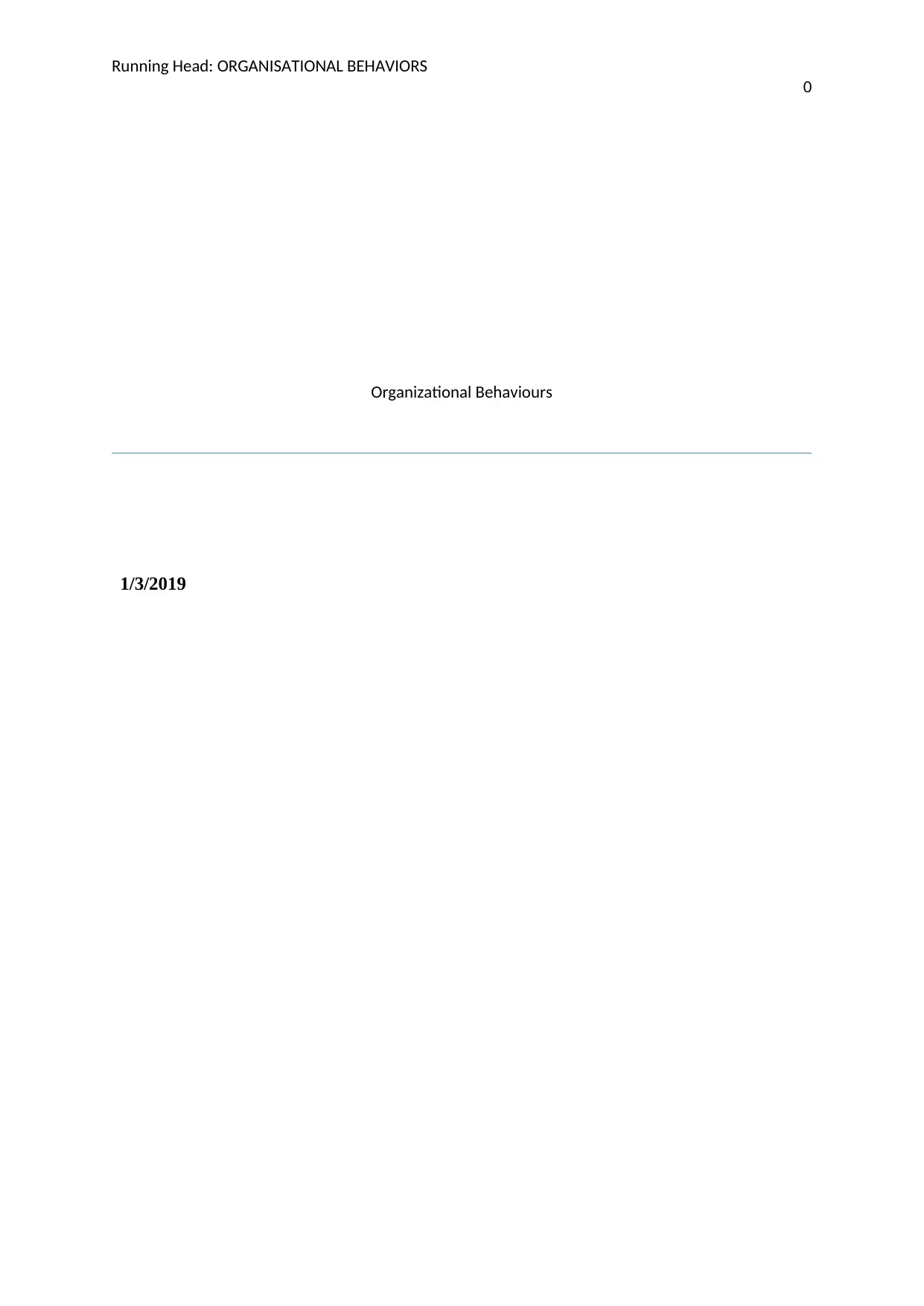
Running Head: ORGANISATIONAL BEHAVIORS
0
Organizational Behaviours
1/3/2019
0
Organizational Behaviours
1/3/2019
Paraphrase This Document
Need a fresh take? Get an instant paraphrase of this document with our AI Paraphraser
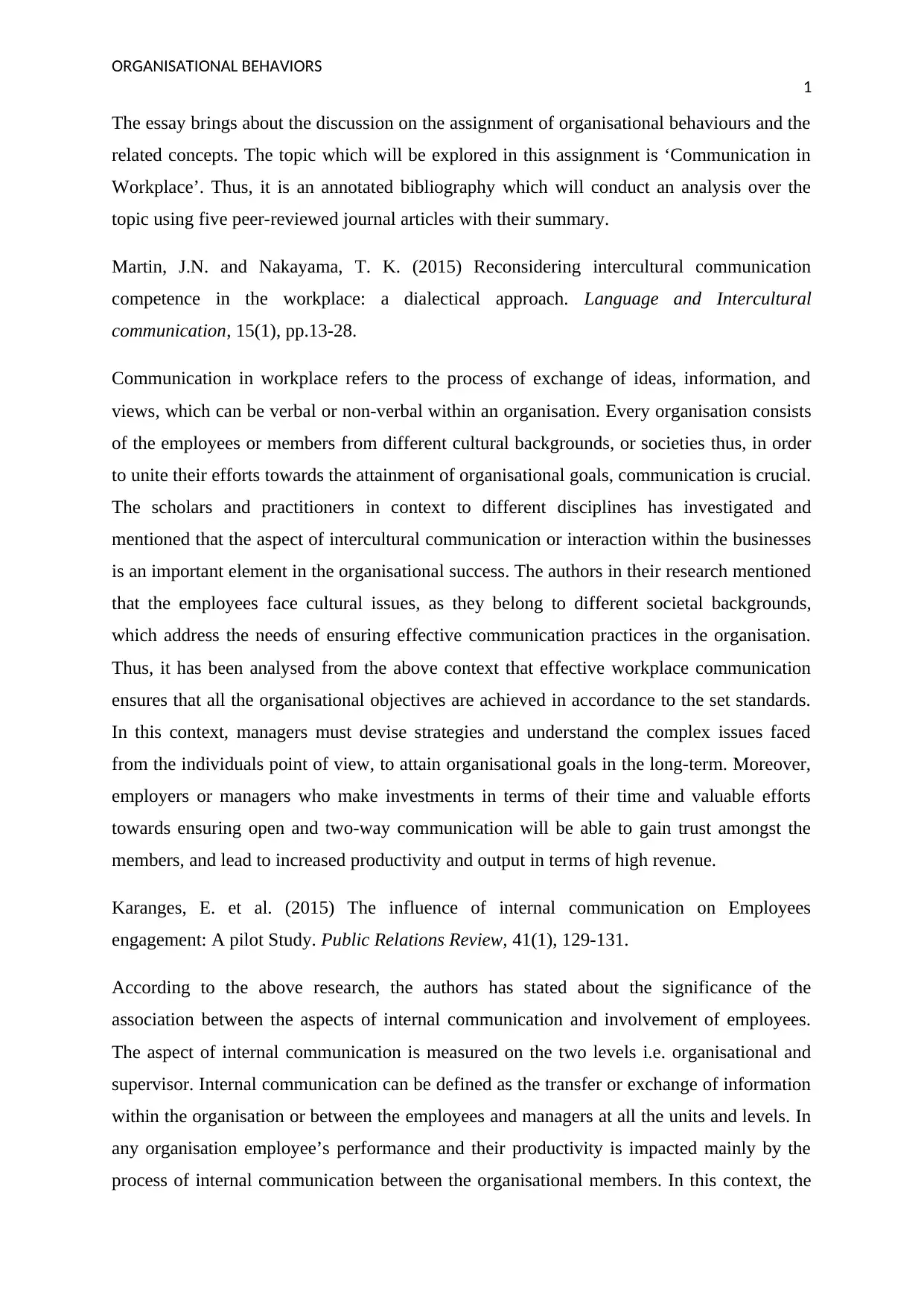
ORGANISATIONAL BEHAVIORS
1
The essay brings about the discussion on the assignment of organisational behaviours and the
related concepts. The topic which will be explored in this assignment is ‘Communication in
Workplace’. Thus, it is an annotated bibliography which will conduct an analysis over the
topic using five peer-reviewed journal articles with their summary.
Martin, J.N. and Nakayama, T. K. (2015) Reconsidering intercultural communication
competence in the workplace: a dialectical approach. Language and Intercultural
communication, 15(1), pp.13-28.
Communication in workplace refers to the process of exchange of ideas, information, and
views, which can be verbal or non-verbal within an organisation. Every organisation consists
of the employees or members from different cultural backgrounds, or societies thus, in order
to unite their efforts towards the attainment of organisational goals, communication is crucial.
The scholars and practitioners in context to different disciplines has investigated and
mentioned that the aspect of intercultural communication or interaction within the businesses
is an important element in the organisational success. The authors in their research mentioned
that the employees face cultural issues, as they belong to different societal backgrounds,
which address the needs of ensuring effective communication practices in the organisation.
Thus, it has been analysed from the above context that effective workplace communication
ensures that all the organisational objectives are achieved in accordance to the set standards.
In this context, managers must devise strategies and understand the complex issues faced
from the individuals point of view, to attain organisational goals in the long-term. Moreover,
employers or managers who make investments in terms of their time and valuable efforts
towards ensuring open and two-way communication will be able to gain trust amongst the
members, and lead to increased productivity and output in terms of high revenue.
Karanges, E. et al. (2015) The influence of internal communication on Employees
engagement: A pilot Study. Public Relations Review, 41(1), 129-131.
According to the above research, the authors has stated about the significance of the
association between the aspects of internal communication and involvement of employees.
The aspect of internal communication is measured on the two levels i.e. organisational and
supervisor. Internal communication can be defined as the transfer or exchange of information
within the organisation or between the employees and managers at all the units and levels. In
any organisation employee’s performance and their productivity is impacted mainly by the
process of internal communication between the organisational members. In this context, the
1
The essay brings about the discussion on the assignment of organisational behaviours and the
related concepts. The topic which will be explored in this assignment is ‘Communication in
Workplace’. Thus, it is an annotated bibliography which will conduct an analysis over the
topic using five peer-reviewed journal articles with their summary.
Martin, J.N. and Nakayama, T. K. (2015) Reconsidering intercultural communication
competence in the workplace: a dialectical approach. Language and Intercultural
communication, 15(1), pp.13-28.
Communication in workplace refers to the process of exchange of ideas, information, and
views, which can be verbal or non-verbal within an organisation. Every organisation consists
of the employees or members from different cultural backgrounds, or societies thus, in order
to unite their efforts towards the attainment of organisational goals, communication is crucial.
The scholars and practitioners in context to different disciplines has investigated and
mentioned that the aspect of intercultural communication or interaction within the businesses
is an important element in the organisational success. The authors in their research mentioned
that the employees face cultural issues, as they belong to different societal backgrounds,
which address the needs of ensuring effective communication practices in the organisation.
Thus, it has been analysed from the above context that effective workplace communication
ensures that all the organisational objectives are achieved in accordance to the set standards.
In this context, managers must devise strategies and understand the complex issues faced
from the individuals point of view, to attain organisational goals in the long-term. Moreover,
employers or managers who make investments in terms of their time and valuable efforts
towards ensuring open and two-way communication will be able to gain trust amongst the
members, and lead to increased productivity and output in terms of high revenue.
Karanges, E. et al. (2015) The influence of internal communication on Employees
engagement: A pilot Study. Public Relations Review, 41(1), 129-131.
According to the above research, the authors has stated about the significance of the
association between the aspects of internal communication and involvement of employees.
The aspect of internal communication is measured on the two levels i.e. organisational and
supervisor. Internal communication can be defined as the transfer or exchange of information
within the organisation or between the employees and managers at all the units and levels. In
any organisation employee’s performance and their productivity is impacted mainly by the
process of internal communication between the organisational members. In this context, the
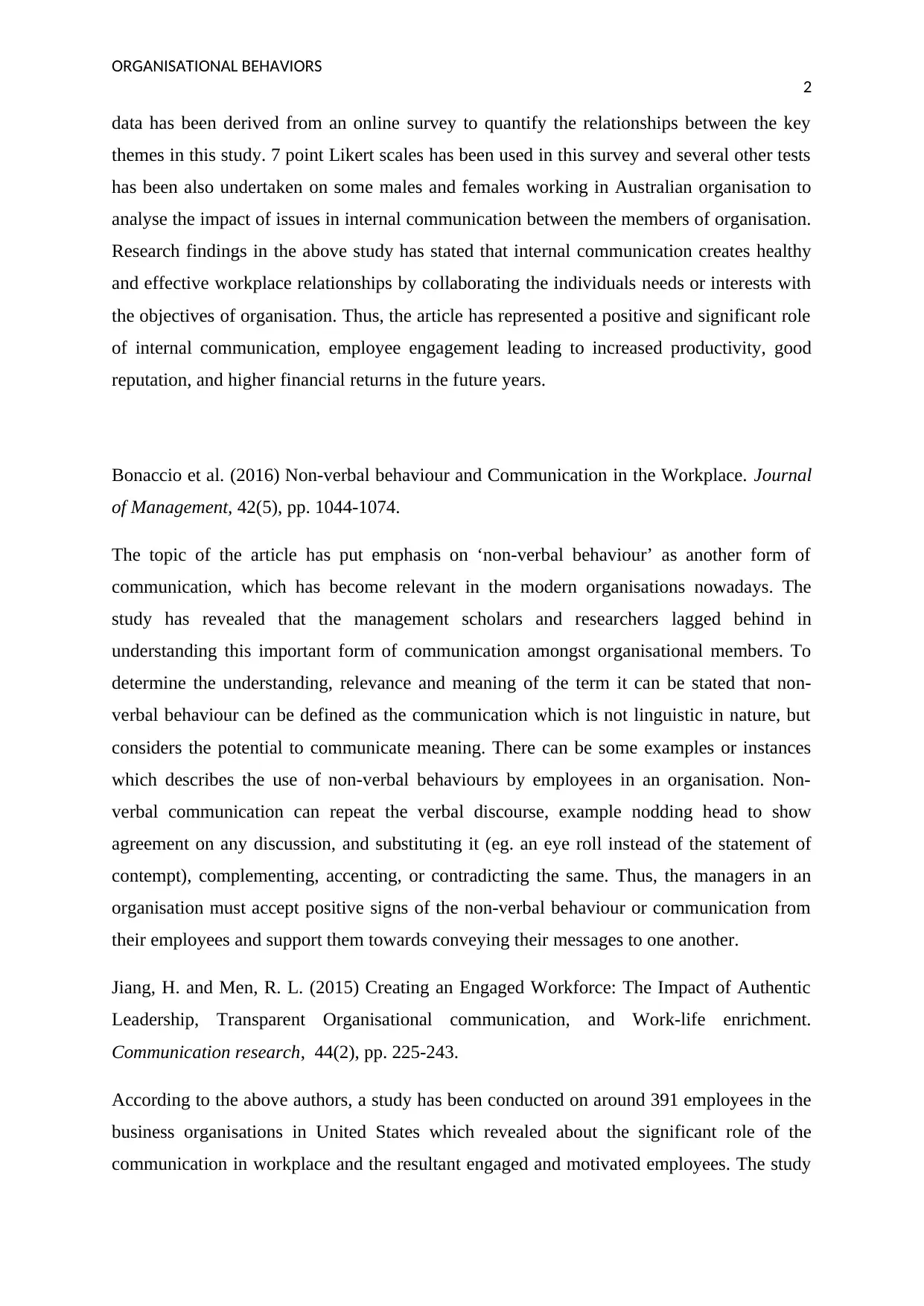
ORGANISATIONAL BEHAVIORS
2
data has been derived from an online survey to quantify the relationships between the key
themes in this study. 7 point Likert scales has been used in this survey and several other tests
has been also undertaken on some males and females working in Australian organisation to
analyse the impact of issues in internal communication between the members of organisation.
Research findings in the above study has stated that internal communication creates healthy
and effective workplace relationships by collaborating the individuals needs or interests with
the objectives of organisation. Thus, the article has represented a positive and significant role
of internal communication, employee engagement leading to increased productivity, good
reputation, and higher financial returns in the future years.
Bonaccio et al. (2016) Non-verbal behaviour and Communication in the Workplace. Journal
of Management, 42(5), pp. 1044-1074.
The topic of the article has put emphasis on ‘non-verbal behaviour’ as another form of
communication, which has become relevant in the modern organisations nowadays. The
study has revealed that the management scholars and researchers lagged behind in
understanding this important form of communication amongst organisational members. To
determine the understanding, relevance and meaning of the term it can be stated that non-
verbal behaviour can be defined as the communication which is not linguistic in nature, but
considers the potential to communicate meaning. There can be some examples or instances
which describes the use of non-verbal behaviours by employees in an organisation. Non-
verbal communication can repeat the verbal discourse, example nodding head to show
agreement on any discussion, and substituting it (eg. an eye roll instead of the statement of
contempt), complementing, accenting, or contradicting the same. Thus, the managers in an
organisation must accept positive signs of the non-verbal behaviour or communication from
their employees and support them towards conveying their messages to one another.
Jiang, H. and Men, R. L. (2015) Creating an Engaged Workforce: The Impact of Authentic
Leadership, Transparent Organisational communication, and Work-life enrichment.
Communication research, 44(2), pp. 225-243.
According to the above authors, a study has been conducted on around 391 employees in the
business organisations in United States which revealed about the significant role of the
communication in workplace and the resultant engaged and motivated employees. The study
2
data has been derived from an online survey to quantify the relationships between the key
themes in this study. 7 point Likert scales has been used in this survey and several other tests
has been also undertaken on some males and females working in Australian organisation to
analyse the impact of issues in internal communication between the members of organisation.
Research findings in the above study has stated that internal communication creates healthy
and effective workplace relationships by collaborating the individuals needs or interests with
the objectives of organisation. Thus, the article has represented a positive and significant role
of internal communication, employee engagement leading to increased productivity, good
reputation, and higher financial returns in the future years.
Bonaccio et al. (2016) Non-verbal behaviour and Communication in the Workplace. Journal
of Management, 42(5), pp. 1044-1074.
The topic of the article has put emphasis on ‘non-verbal behaviour’ as another form of
communication, which has become relevant in the modern organisations nowadays. The
study has revealed that the management scholars and researchers lagged behind in
understanding this important form of communication amongst organisational members. To
determine the understanding, relevance and meaning of the term it can be stated that non-
verbal behaviour can be defined as the communication which is not linguistic in nature, but
considers the potential to communicate meaning. There can be some examples or instances
which describes the use of non-verbal behaviours by employees in an organisation. Non-
verbal communication can repeat the verbal discourse, example nodding head to show
agreement on any discussion, and substituting it (eg. an eye roll instead of the statement of
contempt), complementing, accenting, or contradicting the same. Thus, the managers in an
organisation must accept positive signs of the non-verbal behaviour or communication from
their employees and support them towards conveying their messages to one another.
Jiang, H. and Men, R. L. (2015) Creating an Engaged Workforce: The Impact of Authentic
Leadership, Transparent Organisational communication, and Work-life enrichment.
Communication research, 44(2), pp. 225-243.
According to the above authors, a study has been conducted on around 391 employees in the
business organisations in United States which revealed about the significant role of the
communication in workplace and the resultant engaged and motivated employees. The study
⊘ This is a preview!⊘
Do you want full access?
Subscribe today to unlock all pages.

Trusted by 1+ million students worldwide
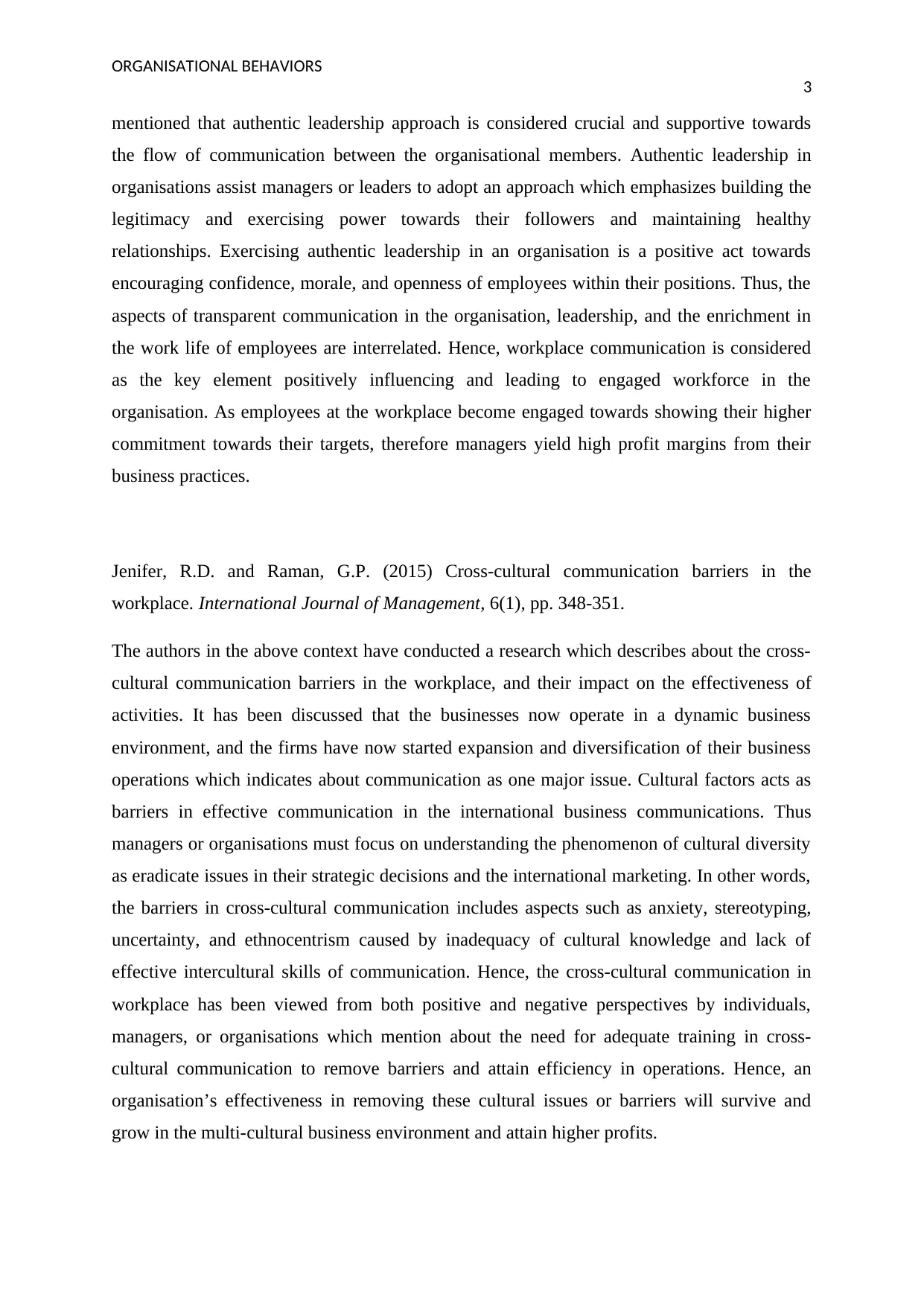
ORGANISATIONAL BEHAVIORS
3
mentioned that authentic leadership approach is considered crucial and supportive towards
the flow of communication between the organisational members. Authentic leadership in
organisations assist managers or leaders to adopt an approach which emphasizes building the
legitimacy and exercising power towards their followers and maintaining healthy
relationships. Exercising authentic leadership in an organisation is a positive act towards
encouraging confidence, morale, and openness of employees within their positions. Thus, the
aspects of transparent communication in the organisation, leadership, and the enrichment in
the work life of employees are interrelated. Hence, workplace communication is considered
as the key element positively influencing and leading to engaged workforce in the
organisation. As employees at the workplace become engaged towards showing their higher
commitment towards their targets, therefore managers yield high profit margins from their
business practices.
Jenifer, R.D. and Raman, G.P. (2015) Cross-cultural communication barriers in the
workplace. International Journal of Management, 6(1), pp. 348-351.
The authors in the above context have conducted a research which describes about the cross-
cultural communication barriers in the workplace, and their impact on the effectiveness of
activities. It has been discussed that the businesses now operate in a dynamic business
environment, and the firms have now started expansion and diversification of their business
operations which indicates about communication as one major issue. Cultural factors acts as
barriers in effective communication in the international business communications. Thus
managers or organisations must focus on understanding the phenomenon of cultural diversity
as eradicate issues in their strategic decisions and the international marketing. In other words,
the barriers in cross-cultural communication includes aspects such as anxiety, stereotyping,
uncertainty, and ethnocentrism caused by inadequacy of cultural knowledge and lack of
effective intercultural skills of communication. Hence, the cross-cultural communication in
workplace has been viewed from both positive and negative perspectives by individuals,
managers, or organisations which mention about the need for adequate training in cross-
cultural communication to remove barriers and attain efficiency in operations. Hence, an
organisation’s effectiveness in removing these cultural issues or barriers will survive and
grow in the multi-cultural business environment and attain higher profits.
3
mentioned that authentic leadership approach is considered crucial and supportive towards
the flow of communication between the organisational members. Authentic leadership in
organisations assist managers or leaders to adopt an approach which emphasizes building the
legitimacy and exercising power towards their followers and maintaining healthy
relationships. Exercising authentic leadership in an organisation is a positive act towards
encouraging confidence, morale, and openness of employees within their positions. Thus, the
aspects of transparent communication in the organisation, leadership, and the enrichment in
the work life of employees are interrelated. Hence, workplace communication is considered
as the key element positively influencing and leading to engaged workforce in the
organisation. As employees at the workplace become engaged towards showing their higher
commitment towards their targets, therefore managers yield high profit margins from their
business practices.
Jenifer, R.D. and Raman, G.P. (2015) Cross-cultural communication barriers in the
workplace. International Journal of Management, 6(1), pp. 348-351.
The authors in the above context have conducted a research which describes about the cross-
cultural communication barriers in the workplace, and their impact on the effectiveness of
activities. It has been discussed that the businesses now operate in a dynamic business
environment, and the firms have now started expansion and diversification of their business
operations which indicates about communication as one major issue. Cultural factors acts as
barriers in effective communication in the international business communications. Thus
managers or organisations must focus on understanding the phenomenon of cultural diversity
as eradicate issues in their strategic decisions and the international marketing. In other words,
the barriers in cross-cultural communication includes aspects such as anxiety, stereotyping,
uncertainty, and ethnocentrism caused by inadequacy of cultural knowledge and lack of
effective intercultural skills of communication. Hence, the cross-cultural communication in
workplace has been viewed from both positive and negative perspectives by individuals,
managers, or organisations which mention about the need for adequate training in cross-
cultural communication to remove barriers and attain efficiency in operations. Hence, an
organisation’s effectiveness in removing these cultural issues or barriers will survive and
grow in the multi-cultural business environment and attain higher profits.
Paraphrase This Document
Need a fresh take? Get an instant paraphrase of this document with our AI Paraphraser
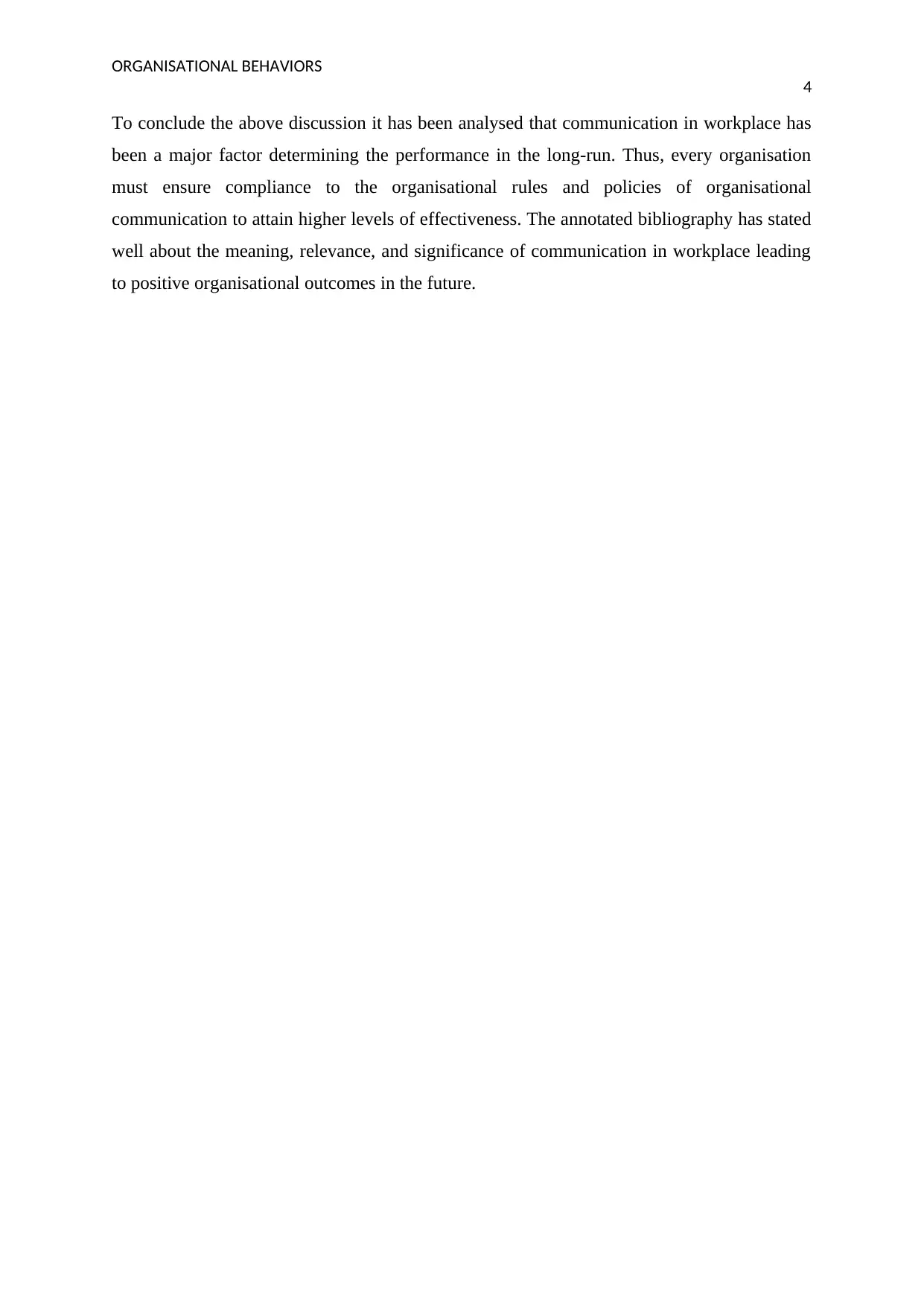
ORGANISATIONAL BEHAVIORS
4
To conclude the above discussion it has been analysed that communication in workplace has
been a major factor determining the performance in the long-run. Thus, every organisation
must ensure compliance to the organisational rules and policies of organisational
communication to attain higher levels of effectiveness. The annotated bibliography has stated
well about the meaning, relevance, and significance of communication in workplace leading
to positive organisational outcomes in the future.
4
To conclude the above discussion it has been analysed that communication in workplace has
been a major factor determining the performance in the long-run. Thus, every organisation
must ensure compliance to the organisational rules and policies of organisational
communication to attain higher levels of effectiveness. The annotated bibliography has stated
well about the meaning, relevance, and significance of communication in workplace leading
to positive organisational outcomes in the future.
1 out of 5
Related Documents
Your All-in-One AI-Powered Toolkit for Academic Success.
+13062052269
info@desklib.com
Available 24*7 on WhatsApp / Email
![[object Object]](/_next/static/media/star-bottom.7253800d.svg)
Unlock your academic potential
Copyright © 2020–2025 A2Z Services. All Rights Reserved. Developed and managed by ZUCOL.




